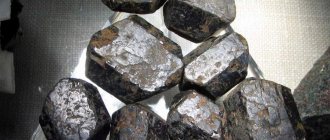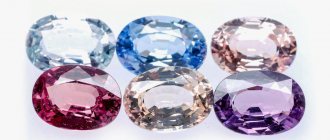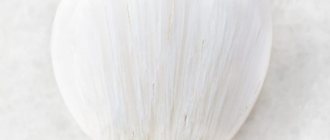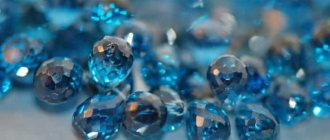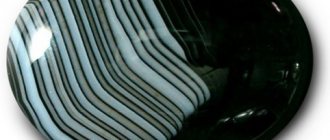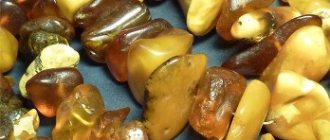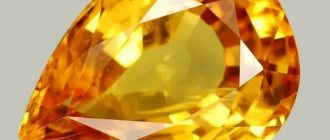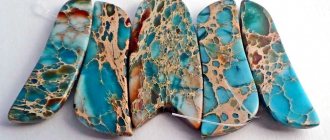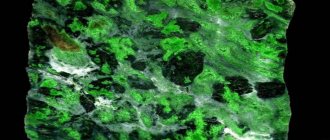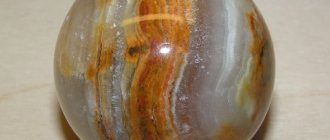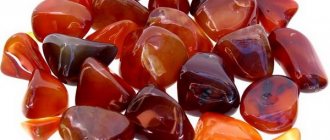Knowing the history of the emergence of Vesuvian, I would like to doubt that the formidable volcano Vesuvius can bring misfortune and misfortune to humanity. After all, it was he who gave people this wonderful gem.
Vesuvian is so beautiful that experts often put it on a par with jade, rose quartz and malachite.
The stone is considered semi-precious of the first order; it is a silicate of aluminum and calcium with other impurities.
Today we will look at the properties and characteristics of vesuvian in more detail.
Origin story
The first mention of the stone appeared in the 18th century, in 1795, when Abraham Gottlob Werner, a famous mineralogist from Germany, found several small stones.
The color especially caught my attention: greenish-brown. It is known that Werner was not the discoverer, but gave a beautiful name - Vesuvian, given, as is already clear, in honor of the famous volcano.
Vesuvianite forms in mafic and ultramafic igneous rocks, characteristic of serpentinites; may form in skarns as a result of regional or contact metamorphism of limestones.
They are least often found in igneous and alkaline rocks.
The discoverer of the long-known
In the 18th century, the Age of Enlightenment began in Europe, the apotheosis of the medieval Renaissance of science and culture, undertaken by the great ascetics of European civilization - from Dante and Petrarch to Leonardo da Vinci and Michelangelo.
Enlightenment scientists questioned millennia-old dogmas. Among them was a graduate of the University of Leipzig, professor of the Freiberg Mining Academy (Saxony) Abraham Werner.
This name often appears on the pages of our encyclopedia. After all, Academician Abraham Werner is the father of descriptive mineralogy and the “godfather” of many ores, rocks and minerals.
In 1795, Werner studied crystals brought to his laboratory from southern Italy, from the slopes of the fire-breathing Mount Vesuvius. They have been known since ancient times, but there was no consensus about their belonging to one or another gem.
The most modern instruments at that time, optical and chemical research methods allowed the professor to establish that in front of him was a chameleon mineral, not previously described. Werner named it after the volcano that gave birth to the samples - Vesuvian .
Meaning
Minerals are often named after the countries or places where they were found, or based on external features and the presence of a certain element in greater quantities than other specimens.
Vesuvian has several other names and meanings, in addition to the main one:
- Idokraz means “mixed form” in Greek. The name was invented by scientists from France, since the stone really has many shapes. This variety has a bluish or greenish-blue tint.
- American jade (californite). The name is given according to the place of discovery. These stones are bright, rich green in color. The appearance resembles jade or jadeite.
- Cerium vesuvian. The gem contains cerium.
- Vilyui emerald , given by analogy with the name of the Vilyui river, located in Yakutia. There are deposits of not only vesuvianite, but also other minerals from its group, for example, viluite.
- Tseprin. Contains copper. Translated from Latin “Cypriot”, that is, “cuprum”. Copper was brought in large quantities from Cyprus, hence the name. This stone was discovered in Norway.
- Xanthite. From the ancient Greek “yellow”, which determined the name. Manganese was found in the mineral.
- Chromidekras. A mineral that contains large amounts of chromium.
- American jade.
- Glass agate.
- Pakistani jade.
- Genevit.
- Volcanic chrysolite.
- Beryllium vesuvianite.
- Vesuvianite.
- Italian peridot.
- Egeran. The name is German, outdated.
Note: Vesuvianite is sometimes found in association with diopside. Scientists tend to assume that the formation and crystallization of these two minerals occurred in parallel.
You can see how they often replace each other or form very nearby mineral brushes of crystals.
Bright green or brownish green vesuvian can easily be confused with epidote or diopside when cut. The difference can be identified only with the help of knowledge about the optical properties and differences of minerals.
Description and types of Vesuvian
Vesuvian is a stone with a columnar, prismatic or pyramidal shape. Its crystals are transparent or translucent.
In nature it occurs as individual crystals or dense granular masses. Color: green, yellow, brown.
There are several types of stone:
- californite is a dense mass not divided into individual crystals;
- cyprin - contains inclusions of copper, has a bluish color;
- xanthite - has a yellow-brown color;
- greenish crystals are called American jade;
- samples with a high chromium content have a bright green tint and are called chromidocrases.
Vesuvian is also called idocrase, “like others.” The fact is that stone crystals often resemble other minerals.
The cost of a gem depends on its quality. Small tumbling costs 200–300 rubles per piece. Jewelry-quality samples measuring 2 cm are valued at 3–5 thousand rubles. A bracelet or beads will cost 7–10 thousand rubles.
View this post on Instagram
Posted by @the_minerals_world Dec 9, 2021 at 2:02 PST
Physical properties
Vesuvian is a complex silicate and has a long formula. Main components: silicon (39%), calcium (37%), aluminum (16%), commonly found: iron, beryllium, boron, sodium, copper, chromium, magnesium, strontium, lithium.
There are also many inclusions - rare earth elements: cerium, scandium, yttrium, lanthanum. Therefore, the mineral exhibits metamictivity - the ability to transition from a crystalline state to a glassy amorphous one.
- Vesuvian is a crystalline dielectric (pyroelectric).
- IMA class - silicates (according to the USSR taxonomy - silicates).
- IMA status: valid, Vesuvian first described before 1959 (before IMA).
Form of isolation: crystals are long- and short-prismatic, often bipyramidal, have a square cross-section; solid cryptocrystalline masses; the aggregates are granular, columnar, radially radiant, up to 15 cm.
The crystals are complex, with up to 30 shapes noted for a single crystal.
Characteristic:
| Chemical formula | Ca10(Mg,Fe)2Al4[OH4(SiO4)5(Si2O7)2] |
| Color | Dark green, brown, brown, greenish yellow, grassy, bluish |
| Stroke color | White (transparent) |
| Kink | Uneven, conchoidal |
| Density | 3.35 –3.45 g/cm3 |
| Transparency | Translucent, transparent, see-through |
| Hardness | 6,5 – 7,0 |
| Refractive indices | nω = 1.703 – 1.752 nε = 1.700 – 1.746 |
| Cleavage | imperfect in {110}very imperfect in {001}very imperfect in {100} |
| Thermal properties | In a blowpipe it swells and easily melts into yellow-green or brown glass |
| Shine | Resin, glass |
| Optical ray dispersion | Strong |
| Birefringence (maximum) | δ = 0.003 – 0.006 |
Pleochroism is weak, the system is tetragonal.
Since Vesuvian has a variable composition, its crystalline form also changes; cubes, columns, pyramids, prisms and their intergrowths can be observed fused together.
Place of Birth
The largest deposits were found in Canada (Quebec), as well as in Italy, Norway, Pakistan, Switzerland, the USA, and northern Africa. In Asia - in Russia and China, Kazakhstan.
In Russia, large deposits have been discovered in Yakutia (Sakha, Vilyuisky site), Sverdlovsk region (Asbestovsky urban district, Bazhenovsky deposit), in Karelia (Pitkyaranta district, New ore field), as well as in the territory of Nizhny Tagil and in the Sayan Mountains.
Varieties, colors
Vesuvian with grossular
Vesuviana, as already noted, contains various elements, the presence and percentage of which varies depending on the location of the find and the depth of occurrence.
The most famous are: Fluorine, Aluminum, Berrylium, Chromium, Silicon, Magnesium, Copper, Iron.
| Classification | Definitions |
| By color |
|
| By shape |
|
Black
Brown
Bluish
Depending on the place of origin and extraction, Vesuvian has another classification by name. For example, Californianite, Pakistani or Italian jade, Vilyui emerald and others.
Idocraz: mixing of forms
Vesuvian is extremely diverse. It is found in the form of beautiful crystals, like a first-class gem, and in the form of an ornamental monolithic rock in huge blocks, like malachite or jade. In monolithic blocks, vesuvians are difficult to distinguish from jade.
Gem crystals are most often prismatic and pyramidal. But if you take a good look at their structure under a strong microscope, you will notice that they are made up of small, regular cubes.
This observation prompted Professor Werner to give Vesuvian a second name - idocrase . In Greek, the word means "a mixture of geometric shapes."
Magic properties
The main thing is that the owner of the stone has pure thoughts and honest intentions.
Different shades of Vesuvian can have a beneficial effect on the main areas of life.
The mineral is actively used by magicians and sorcerers: it has great energy power.
- The red stone helps to improve your personal life, develop sexuality and restore potency, and find your soulmate.
- Green gems will be useful for those involved in business, as well as creative people who develop their abilities.
- The blue mineral promotes harmony in family life and career.
The stone helps to bring comfort to your home, improve relationships, tidy up your appearance, and change your style. It provides assistance to active and purposeful people, athletes, public figures, and businessmen.
Medicinal properties
Vesuvian has unique healing properties. It helps restore the immune system and increase the body's resistance to viruses and infections.
It has a beneficial effect on the central nervous system, improves vision, and relieves headaches.
Properties:
- Vesuvian with a green tint is recommended for the treatment of the cardiovascular system.
- Yellow stones restore the functions of the stomach and intestines and help get rid of overeating.
- The blue mineral has a remarkable effect on the endocrine system.
- A pale green gem will help tidy up your skin.
Vesuvian successfully acts as an aid in getting rid of bad habits, helps to harmonize the emotional sphere, and relieves negative experiences and anxiety.
The magic of Vesuvian
Vesuvian stone was formed in bubbling magma deep in the bowels of the Earth, and thrown to the surface in streams of viscous hot lava. It is often found in frozen lava. This mineral is inextricably linked with volcanoes and the underground astral world.
But he also has another magical feature. As the alchemists say, “there is a mirror hidden in this stone.”
Even in ancient times, Babylonian and Egyptian alchemist magicians found out that this mineral (no matter what it was called then) could be melted. The result is green bubbly glass. Wizards knew how to cast and polish it, and then use the magic mirror to communicate with spirits.
Who is suitable according to their zodiac sign?
The mineral has extraordinary power and is recommended for any sign in difficult situations to maintain mental state.
But Vesuvian especially favors the “Fire” element: Sagittarius and Aries . Of the “Earth” stones, the stone is most suitable for Virgo , and for “Water”, the gem should be chosen for Scorpio .
Mimicry
As if mocking gemologists, Idokras dresses up first as one gemstone, then as another. Its mimicry is the pinnacle of the art of camouflage among minerals.
After testing with modern equipment, some famous tourmalines and sapphires “turned” into the many-sided Vesuvianite.
But sometimes the opposite happens.
Who is the name suitable for?
According to observations, Vesuvians, especially those found near Vesuvius, are capricious: they can bring good luck and trouble to the owner in equal measure. Therefore, you need to choose a stone, additionally focusing on the name.
- Female names: Veronica, Agata, Angelina, Vera, Daria, Masha, Milena, Mila, Mira, Ella and Karina.
- Male names: Eduard, Karim, Dobrynya, Lyubomir, Miroslav, Mikhail.
Talismans and amulets
You can simply carry a crystal with you as an amulet, in a secret pocket or bag.
To protect your home, it is enough to store Vesuvian in a box. But, if possible, purchased, a box or egg made of Vesuvian will be able to fully harmonize the space in the house.
If the owner feels the help of the stone and “made friends” with it, then it is allowed to constantly wear earrings or a bracelet, and for men, a ring or business card holder, stationery.
How Vesuvian turned into a unique sapphirine
Twenty years ago, a collector from California sent experts at the Gemological Institute of America (GIA) a very unusual cut stone of a rich cherry brown color. When the jewel was turned, orange flashes played in the edges.
The gem was found in Tanzania, in the mines of the Tunduru deposit. A collector bought it quite inexpensively as an Idocrasus Vesuvian.
Doubts about the identification arose among a jeweler and gemologist, to whom the owner showed the acquisition for evaluation. The specialist noticed that the stone has trichroism, which is not typical for Vesuvianite: red/brown/orange + colorless. Vesuvian is only supposed to have weak dichroism, that is, barely distinguishable two-color. The refractive index of light in the faces was also anomalous for Vesuvian. The jeweler did not have the equipment for a deeper study of the properties of the Vesuvian stone.
The GIA optical laboratory carried out a spectrological examination, supported by data from X-ray structural and chemical analysis.
It turned out that the imaginary idocrase turned out to be a red sapphirine, and the largest of the known ones - 8.64 carats. In addition, it became the first red sapphirine found in Tanzania.
Decorations
Pendants, earrings, bracelets and rings are suitable for women. Men can wear rings and cufflinks.
Vesuvian can be combined with other precious stones to form an interesting ensemble.
The cheapest frame is silver. In platinum and gold it can be very expensive, on par with other precious stones.
Where is it used?
Vesuvian is fragile, but due to its hardness it is in demand by jewelers. Craftsmen have found use for translucent and transparent gems.
Classified as semi-precious, the cost of specimens with thick colors and the effect of pleochroism is comparable to first-line stones. The cheapest frame is high-grade silver.
Earrings with Vesuvian
Opaque raw materials are a popular material for baths or saunas.
Price and care
The mineral is quite fragile and requires attention. It is advisable to store it in a box. Easy to care for: rinse with water and wipe with a soft cloth.
In the Russian Federation you can purchase jewelry and stones for your collection. The cost of unprocessed copies is from 4 dollars.
- Egg (Kazakhstan), size: 4 – 5 cm – 5200 – 7600 rub.
- Crystal (China) – 5100 rub.
- Galtovka (USA) – 360 – 550 rubles.
How to distinguish from a fake?
Vesuvian is a fairly rare stone and is only gaining popularity in Russia.
When purchasing, you need to take into account several features that will help distinguish a real mineral from a fake:
- You need to look at the mineral in the light: the cubes should be visible (the stone seems to be made up of them).
- When exposed to sunlight, a yellow, greenish or orange glow is noticeable.
- Transparent specimens are usually used for decorations.
- Vesuvian is characterized by small inclusions of gray, brown or brown tint.
- The cost cannot be small, because some stones are considered especially valuable.
However, sometimes Vesuvian is passed off as an emerald: the structure of the crystals and their fracturing are similar. But vesuvianite “gives” pleochroism; it is enough to examine the mineral in polarized light.
Frequently encountered unrecognizable
Vesuvian stone is not a particularly rare mineral.
It can be found on all continents, in places of volcanic activity - current or very ancient. Detected, and... not recognized! Its chemical formula, given in mineralogical reference books, is so complex that it barely fits on the printed line. This means that the appearance of the stone is very diverse. We can say that Vesuvian is a performing stone. A simpler description of the mineral sounds like this: a complex silicate of calcium and aluminum. The word “complex” refers to the many impurities that give the stone a variety of colors and textures.
The mineral invariably contains iron, fluorine, and hydroxyl. And then many elements of the periodic table are mixed in bizarre proportions in a giant alchemical retort of a volcanic vent, randomly giving rise to the most unexpected forms and varieties of the Vesuvian mineral.
What stones does it go with?
Mineralogists advise combining Vesuvianite only with powerful precious stones, otherwise it “suppresses” with powerful energy.
The best “neighbors” for this mineral: Malachite, Jade, Alexandrite, Emerald, Chrysoberyl, Sapphire, Diamond, Amber, Tourmaline, Agate, Topaz, Aquamarine, Aventurine.
Combination with other minerals
In jewelry, Vesuvian is combined only with energetically strong gems, otherwise the “neighbors” will pale in comparison. Amber, malachite, emerald, sapphire, agate, alexandrite, tourmaline, aquamarine, jade and diamond are suitable for these purposes.
Interesting Facts
- The stones from Quebec are striking in their size: the find can be almost 15 carats.
- Vesuvian is believed to bring good luck and happiness to creative people: artists, architects, musicians and designers.
- If relations with your superiors leave much to be desired, then this mineral helps eliminate negativity and normalize the working atmosphere.
- In Africa, Vesuvian has long been used in rituals: in a few months it completely restores the aura and removes negative energy effects.
Help in relationships
The Vesuvian mineral is considered an ideal assistant in relationships with others. It makes its owner attractive to other people , literally attracting the glances and attention of others. For those who seek to find their happiness, this is a suitable talisman.
If its owner is endowed with negative character traits, then the stone smoothes them out and removes their most striking manifestations. It is ideal for irritable, hot-tempered, pessimistic people. With him, you won’t be able to fall into prolonged melancholy or angrily express to someone everything that has accumulated in your soul. Vesuvian forces you to look for softer approaches in relationships with people, to think more often about the good and see the positive sides in everything that happens.
It is also indispensable when looking for friends. This is a communication stone that helps you find a common language even with those who think completely differently. It allows you to more successfully build conversations with your superiors, thereby bringing profit to the person. Profitable deals and successful contracts are also the sphere of influence of Vesuvianite.
For those who have already started a family, but are in constant conflicts, this mineral will also be useful. It helps to come to an agreement with dear people, restore relationships, remember that people are dear to each other and want to be together no matter what.
